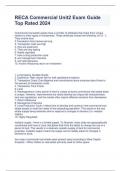Samenvatting
Thomas More - Business Fundamentals - Summary
- Instelling
- Thomas More Hogeschool (tmhs)
Class: Business Fundamentals Lecturer: Carla Kayaerts Phase: Year 1 – Semester 1 Content: Business Model Canvas – Value Proposition Canvas - Patterns in Business models & Blue Ocean Strategy - Mission, vision, values, and development strategy - Structure and organization - Sustainable organi...
[Meer zien]












